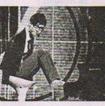根据所给单词及句意,写出单词的适当形式。1. The basketball star will visit their city today and then _____ tomorrow. (we)2. It's my_____ time to come to New Y-七年级英语
factory→factories
party→patries
boy→boys
key→keys
life→lives
wife→wives
half→halves
tomato→tomatoes
hero→heroes
zoo→zoos
妻子骑牛拿起刀,wife,calf,knife ↑
追得贼狼满街跑,thief,wolf →→→变f或fe为v,再加es
碰倒架子丧己命,shelf,self,life ↓
手帕树叶半空飘。handkerchief,leaf,half ↓
1.不规则形式:
child→children(儿童)
man→men(男人)
woman→women (女人)
an Englishman→two Englishmen(英国人)
foot→feet(脚)
tooth→teeth(牙)
mouse→mice(老鼠)
ox →oxen(公牛)
goose→geese(鹅)
2.单复同形:
deer,sheep,fish,Chinese,Japanese, species,means,Swiss
除人民币,美元、英镑、法郎等都有复数形式。
如:a dollar,two dollars; a meter,twometers
3.集体名词,以单数形式出现,但实为复数:
people police cattle是复数
(OK :a person,a policeman,ahead of cattle,the English,the British,the French,the Chinese,the Japanese,the Swiss )
(Error:a people,a police,a cattle )
表示国民总称时,作复数用。
(The Chinese are industries and brave. 中国人民是勤劳勇敢的。)
4.以s结尾,仍为单数的名词
maths,politics,physics等学科名词,为不可数名词,是单数。
news是不可数名词。
5.表示由两部分构成的东西,
glasses(眼镜) trousers (长裤) clothes(衣服)
若表达具体数目,要借助数量词pair(对,双)a pair of glasses two pairs of trousers suit(套)
6.另外还有一些名词,其复数形式有时可表示特别意思
goods (货物) waters (水域) fishes (各种鱼)
1) 单数名词加s: students, apples, bags, trees, books, brothers.
2) 以s、x、sh、ch结尾的名词加es: glasses, boxes, brushes, matches.
3) 以辅音字母加y结尾的名词,变y为i加es: cities, babies, enemies.
4) 以f或fe结尾的名词,多数变f为v加es: wives, knives.但有些词只加s: roofs,proofs, chiefs.
5) 以o结尾的名词,有些加es: Negroes, heroes, tomatoes, potatoes. 其它加s: radio s, zoos, pianos, photos.
6) 不规则名词:foot→feet, goose→geese, tooth→teeth, child→children, man→men, woman→women, mouse→mice.
7) 单复数同形的名词:sheep,fish,dee.
注意:fish表示种类时,也用fishes这样的形式。
考点名称:名词所有格
- 名词所有格:
表示有生命的东西的名词及某些表示时间、距离、星球、世界、国家等无生命的东西的名词,后加’s来表示所有关系。 名词所有格的构成:
①一般情况(包括单数名词和不带词尾s的复数名词)加’s
例如:the child’s bag 这个孩子的书包 children’s books 儿童用书
②带词尾s的复数名词只加省字撇(’)
例如:girls’ school 女子学校 the smiths’ car 史密斯家的小汽车
带词尾s的单数,通常仍加’s,如the boss’s new car
③带词尾s的人名,可加’s或只加省字撇(’)
例如:Dickens’ novels 狄更斯的小说 Charles’ job 查理斯的工作
不带词尾s,却以[s]结尾,一律加’s,如Marx’s 马克思的著作
④双重所有格:将’s与of 结合一起使用构成双重所有格。
例如:a friend of my father’s 我父亲的一位朋友
a photo of mine 我的一张照片
注意:
①用and连接的的并列名词的所有格要分两种情况,即表示各自的所有关系时,要分别在并列名词后加’s,表示共同的所有关系时,只在最后一个名词后加’s。
例:Tom’s and Jack’s room 汤姆和杰克(各自)的房间。
Tom and Jack’s room 汤姆和杰克(共同)的房间。
②下列情况可以将 ’s 所有格中的名词省略。
a名词所有格所修饰的词, 如果前面已经提到,往往可以省略,以免重复。
例 This notebook is not mine, nor John’s, nor Peter’s. 这个笔记本不是我的,也不是约翰和比特的。
The dictionary isn’t mine, but Jenny’s. 这本词典不是我的,而是珍妮的。
b名词所有格后面有指地点等的名词时, 有的在习惯上可以省略。
例 Before Christmas, there were lots of customers at the Richarsons’.
the doctor’s(office)医生的诊所
my uncle’s(house)我叔叔的家-’s 所有格与of 所有格的用法比较:
(1) of 所有格既可用于有生命的人或物,也可用于无生命的东西。of 所有格有时可以与-’s 所有格互换。
如:Mr Smith’s son = the son of Mr Smith 史密斯先生的儿子
Jim’s patience = the patience of Jim 吉姆的耐心
the Queen’s arrival = the arrival of the Queen 女王的到达(2) 必须用 ‘s 所有格的情形:
①表类别时:men’s shoes 男鞋,children’s stories 儿童故事
②表来源时:John’s telegram 约翰的电报
③当被修饰的名词后有同位语修饰时:
Mary’s husband, a policeman, has just been here. 玛丽的丈夫是个警察,刚刚来过这儿。(3) 必须用of 所有格的情形:
①用于无生命的事物时:the subject of the sentence 句子主语
Times New Roman'; mso-ascii-font-family: 'Times New Roman'
②表同位关系时:the City of Beijing 北京市
③当中心词是名词化的名词时:the life of the poor 穷人的生活
④当of 所有格中的名词后跟有后置修饰语或同位语时:
of Mr Smith is a foreign teacher of a university in China. 史密斯先生是中国一所大学的外籍教师。's所有格、of所有格和双重所有格三者之间的细微区别:
举例比较下面三句话:
1.She is Mary's brother's friend.
2.She is a friend of Mary's brother.
3.She is a friend of Mary's brother's.
1句用的是's所有格,侧重说明她和Mary的哥哥是朋友关系,突出friend一词。
2句用的是of所有格,侧重说明她和Mary的哥哥是朋友关系,强调突出了Mary's brother。
3句用的是双重所有格,侧重说明Mary哥哥的朋友不止是一个,她只是其中的一个。- "名词所有格"用法:
名词在句中表示所有关系、所属关系、动作执行者及动作承受者等意义时常需用所有格形式。
名词所有格也称为属格、主格,它主要包括's所有格、of所有格和双重所有格三种表现形式。
一、's 所有格的用法
1.表示有生命的东西的名词末尾加's。例如:
Jim's bed
the man's wife
children's toys
the fox's tail
2.以-es或-s结尾的名词末尾加"'s"。例如:
the students' books
Teachers' Day
my boss' office
a girls' dormitory
3.有些表示时间、距离、度量衡、价值、自然现象、国家、城镇等无生命东西的名词,也可以加's构成所有格。例如:
today's newspaper five minutes'walk a ton's weight a dollar's worth of stamps the moon's rays
4.表示两者共同拥有的人或物(共有)时,只需要后一个名词加's(或')即可。如果表示两者各自的所属关系(各自所有),则每个名词词尾都加上's(或')。例如:
Joan and Jane's room(房间属二人共同所有)
Joan's and Jane's room(指Joan和Jane各自的房间)
5.'s所有格所修饰的词的省略现象
a、表示诊所、店铺或某人的家等地点名词,其名词所有格后的被修饰语常常省略。例如:
I met her at the doctor's(office).我在诊所遇见了她。
He has gone to the tailor's(shop).他到服装店去了。
She went to Mr.Black's(house)yesterday.她昨天到布莱克先生家去了。
b、名词所有格所修饰的词,如果前面已经提到过,往往可以省略,以免重复。例如:
Whose pen is this?It's Tom's.这是谁的钢笔?是汤姆的。
- 最新内容
- 相关内容
- 网友推荐
- 图文推荐
| [家长教育] 孩子为什么会和父母感情疏离? (2019-07-14) |
| [教师分享] 给远方姐姐的一封信 (2018-11-07) |
| [教师分享] 伸缩门 (2018-11-07) |
| [教师分享] 回家乡 (2018-11-07) |
| [教师分享] 是风味也是人间 (2018-11-07) |
| [教师分享] 一句格言的启示 (2018-11-07) |
| [教师分享] 无规矩不成方圆 (2018-11-07) |
| [教师分享] 第十届全国教育名家论坛有感(二) (2018-11-07) |
| [教师分享] 贪玩的小狗 (2018-11-07) |
| [教师分享] 未命名文章 (2018-11-07) |


![—______ is Jenny.—I’m Gina. Nice to meet you.[ ]A. I’mB. His nameC. I’mD. My name-七年级英语](http://www.00-edu.com/d/file/ks/4/2/wuzhudaici/2019-11-29/small48b153aa794daeb090c5d2505d5cbbac1575042450.png)



